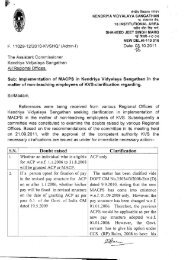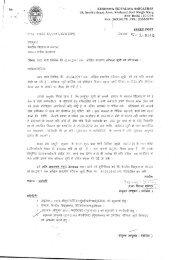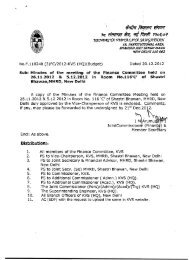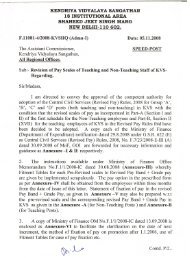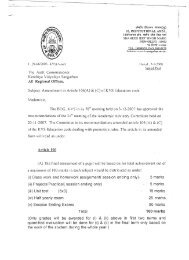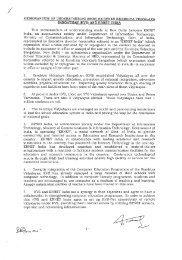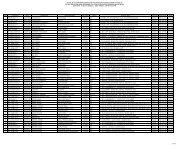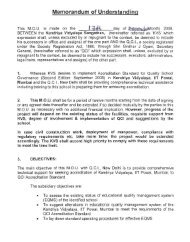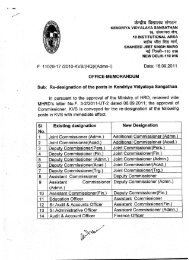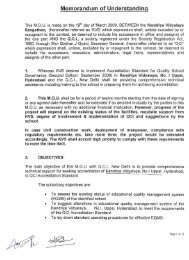Syllabus for written examination for PGT (Biology)
Syllabus for written examination for PGT (Biology)
Syllabus for written examination for PGT (Biology)
Create successful ePaper yourself
Turn your PDF publications into a flip-book with our unique Google optimized e-Paper software.
of two lines, homogeneous equation of second degree in x and y, angle between pair of linesthrough the origin, combined equation of the bisectors of the angles between a pair of lines,condition <strong>for</strong> the general second degree equation to represent a pair of lines, point ofintersection and angle between two lines.Standard <strong>for</strong>m of equation of a circle, general <strong>for</strong>m of the equation of a circle, its radius andcentre, equation of a circle in the parametric <strong>for</strong>m, equation of a circle when the end points ofa diameter are given, points of intersection of a line and a circle with the centre at the originand condition <strong>for</strong> a line to be tangent to the circle, length of the tangent, equation of thetangent, equation of a family of circles through the intersection of two circles, condition <strong>for</strong>two intersecting circles to be orthogonal.Sections of cones, equations of conic sections (parabola, ellipse and hyperbola) in standard<strong>for</strong>ms, condition <strong>for</strong> y = mx + c to be a tangent and point(s) of tangency.Trigonometric Functions:Positive and negative angles. Measuring angles in radians & in degrees and conversion fromone measure to another. Definition of trigonometric functions with the help of unit circle.Graphs of trigonometric functions. Expressing sin (x+y) and cos (x+y) in terms of sinx, siny,cosx & cosy. Identities related to sin2x, cos2x, tan 2x, sin3x, cos3x and tan3x. Solution oftrigonometric equations, Proofs and simple applications of sine and cosine <strong>for</strong>mulae. Solutionof triangles. Heights and Distances.Inverse Trigonometric Functions:Definition, range, domain, principal value branches. Graphs of inverse trigonometric functions.Elementary properties of inverse trigonometric functions.Differential Calculus:Polynomials, rational, trigonometric, logarithmic and exponential functions, Inverse functions.Graphs of simple functions. Limits, Continuity and differentiability; Derivative, Geometricalinterpretation of the derivative, Derivative of sum, difference, product and quotient offunctions. Derivatives of polynomial and trigonometric functions, Derivative of compositefunctions; chain rule, derivatives of inverse trigonometric functions, derivative of implicitfunction. Exponential and logarithmic functions and their derivatives. Logarithmicdifferentiation. Derivative of functions expressed in parametric <strong>for</strong>ms. Second orderderivatives. Rolle's and Lagrange's Mean Value Theorems and their geometric interpretations.Applications of Derivatives:Applications of derivatives: rate of change, increasing / decreasing functions, tangents &normals, approximation, maxima and minima.Integral Calculus:Integral as an anti-derivative. Fundamental integrals involving algebraic, trigonometric,exponential and logarithmic functions. Integration by substitution, by parts and by partialfractions. Integration using trigonometric identities. Definite integrals as a limit of a sum,Fundamental Theorem of Calculus. Basic Properties of definite integrals and evaluation ofdefinite integrals; Applications of definite integrals in finding the area under simple curves,especially lines, areas of circles / Parabolas / ellipses, area between the two curves.Differential Equations:Definition, order and degree, general and particular solutions of a differential equation.Formation of differential equation whose general solution is given. Solution of differentialequations by method of separation of variables, homogeneous differential equations of firstorder and first degree. Solutions of linear differential equation.Vectors:Vectors and scalars, magnitude and direction of a vector. Direction cosines / ratios of vectors.Types of vectors (equal, unit, zero, parallel and collinear vectors), position vector of a point,negative of a vector, components of a vector, addition of vectors, multiplication of a vector bya scalar, position vector of a point dividing a line segment in a given ratio. Scalar (dot)product of vectors, projection of a vector on aline. Vector (cross) product of vectors.Three dimensional Geometry:Coordinates of a point in space, distance between two points; Section <strong>for</strong>mula, Directioncosines / ratios of a line joining two points. Cartesian and vector equationof a line, coplanarand skew lines, shortest distance between two lines. Cartesian and vector equation of a plane.Angle between (i) two lines, (ii) two planes. (iii) a line and a plane. Distance of a point from aplane. Scalar and vector triple product. Application of vectors to plane geometry. Equation of asphere, its centre and radius. Diameter <strong>for</strong>m of the equation of a sphere.Statistics:Calculation of Mean, median and mode of grouped and ungrouped data. Measures ofdispersion; mean deviation, variance and standard deviation of ungrouped / grouped data.Analysis of frequency distributions with equal means but different variances.Probability:Random experiments: outcomes, sample spaces. Events: occurrence of events, exhaustiveevents, mutually exclusive events, Probability of an event, probability of 'not', 'and' & 'or'events., Multiplication theorem on probability. Conditional probability, independent events,,



